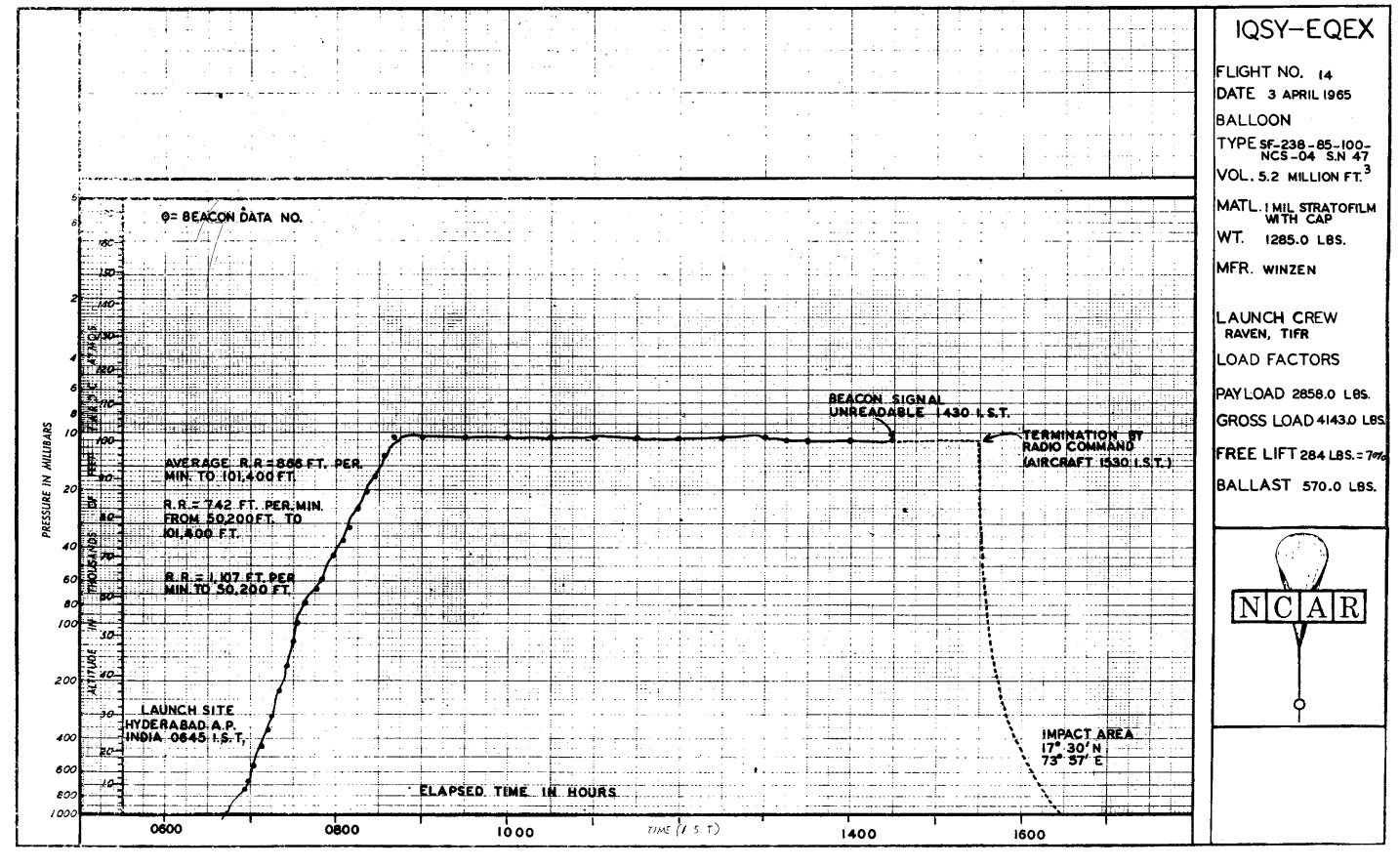Purpose of the flight and payload description
The flight was part of a balloon expedition to study cosmic rays in the vicinity of the equator during the International Quiet Sun Year (IQSY) organized and managed by the National Center for Atmospheric Research as a joint United States - India activity. The program was conducted in Hyderabad, India during the late winter and early spring of 1965.
The main objective of the flight was to launch a composite detector of heavy metal and nuclear emulsion used to investigate ultra-high energy nuclear interactions produced by the cosmic radiation. The exposure was made jointly by the Tata Institute of Fundamental Research, Bombay and University of Bristol, England. This was the heaviest payload flown during the campaign.
Details of the balloon flight

Balloon launched on: 4/3/1965 at 6:45 ist
Launch site: Osmania University Campus, Hyderabad, India
Balloon launched by: Raven Industries Inc.
Balloon manufacturer/size/composition: Zero Pressure Balloon Winzen 5.200.000 cuft (1.0 Mil. Stratofilm-Capped)
Balloon serial number: SF-238.85-100-NCS-04 S/N 47
End of flight (L for landing time, W for last contact, otherwise termination time): 4/3/1965 at 15:30 ist
Balloon flight duration (F: time at float only, otherwise total flight time in d:days / h:hours or m:minutes - ):
Landing site: Payload impact at coordinates: 17º 30' N, 73º 57' E
Campaign: No Data IQSY-EQEX
Payload weight: 2858 lbs
Overall weight: 4143 lbs
The launch was initially scheduled for 29 March, but had to be cancelled due to high surface wind and late arrival of men and equipment at the launch field. A second scheduled flight was cancelled on 30 March due to high surface winds and a late layout schedule, and the flight was scheduled again on 31 March. The surface wind was calm enough at layout, but increased to 6 mph and a squall line developed to the NW. Although the balloon was laid out for 2 hr, inflation was delayed due to faulty valves and hoses. Considerable difficulty developed in the hydrogen manifolding; valves leaked, and crewmen were reluctant to approach the tanks. The system was so uncertain that a dry run appeared to be called for. Due to the long delay and the deteriorating weather, the flight was cancelled a third time. The 5.2 million cu ft balloon was covered with its protective wrapper while the parachute and instruments were removed. The balloon was repacked into the box.
Favorable conditions prevailed on 3 April. The balloon layout and inflation required about 5 hr. The balloon was damaged by the narrow spool in the same manner as the first flight; however, repairs were made using 2-in. polyethylene tape. A smooth launch was accomplished with the launch truck moving about 200 ft. The flight reached a ceiling of 101,400 ft and floated for 7.4 hr. Termination was executed by the tracking aircraft. Impact occurred at 170 30' N, 73° 57' E. Recovery was completed the next morning and the payload was returned the following day to Hyderabad.
External references
- Ballooning Support for Cosmic-Ray Experiments NCAR Technical Note NCAR/TN-20, September 1966
15883If you consider this website interesting or useful, you can help me to keep it up and running with a small donation to cover the operational costs. Just the equivalent of the price of a cup of coffee helps a lot.

